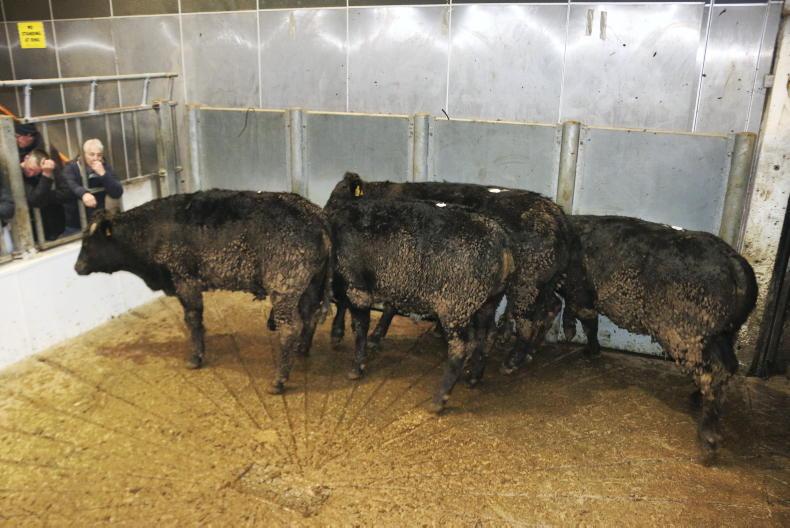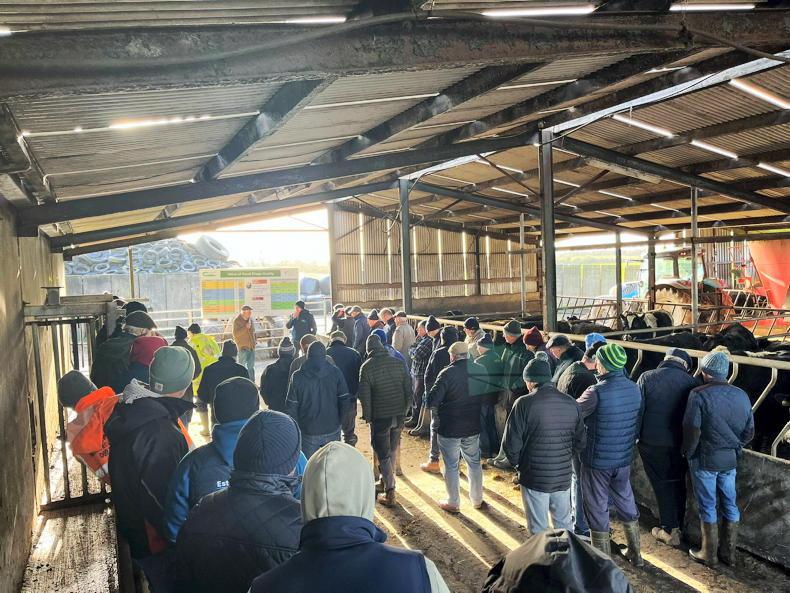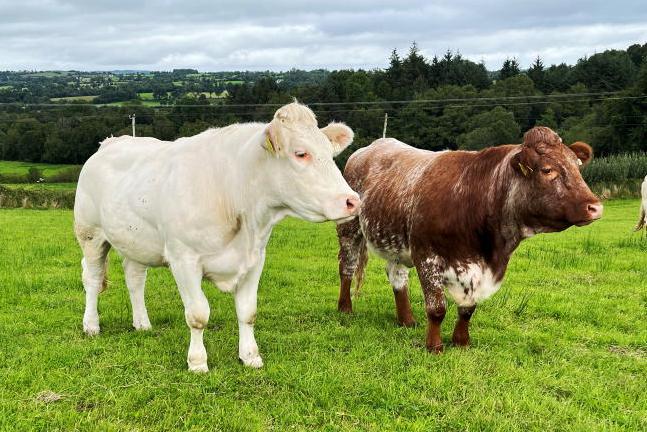Teagasc recently hosted two Dairy Beef 500 conferences in the south of the country, highlighting their new nationwide programme that aims to improve the profitability of dairy beef systems on Irish farms. The target is for farms to achieve a €500/ha net margin before any farm subsidy is taken into account.
The overall campaign is comprised of 15 monitor farms around the country that will receive one-to-one technical advice from the programme team, as well as their local Teagasc advisory team and dairy-beef discussion groups that are currently being established in every county in the country.
Alongside this, Teagasc’s new demonstration farm Ballyvadin, a 276-acre leased farm located in Fethard in south Co Tipperary will play a key role in getting messages and learnings out to the public. The farm aims to rear 300 calves annually, with a target slaughter age of between 20 and 21 months.
Finally, Teagasc’s dairy-beef research teams in Grange and Johnstown Castle will continue to look at factors affecting the profitability and sustainability of dairy-beef systems and disseminate their findings to farmers.
Speaking at the event, Dairy Beef 500 programme manager Alan Dillon said that while the overall target for dairy beef farmers nationally is a €500/ha net margin, the 15 monitor farms will have a target of €1,000/ha net margin, with some farms already surpassing this target.
He outlined that the most successful farms were based on relatively high stocking rates which drove the output from the farm, systems largely based around capturing as much liveweight gain from grazed grass, and a high level of animal health through farm-specific vaccination and dosing programmes.
Calf quality
Dillon commented that many of the monitor farms are operating Holstein Friesian (HF) steer (and some bull) systems, with many having tried beef sired calves and moved away from them once again.
The biggest barrier for the programme farmers moving to more beef-sired calves is the consistency in the quality of the calf. Where beef calves are commanding a purchase price of between €100/head and €150/head more than their HF counterparts, farmers are not convinced they are getting enough of a genetic benefit to justify this price increase – not consistently at least.
Further highlighting this fact, Dr Nicky Byrne, dairy-beef systems researcher in Teagasc Grange showed the carcase weight predicted transmitting ability (PTA) kg of active HF and Angus sires (Figure 1).
As can be seen in the red circle, there is a huge overlap in the carcase weight potential of both breeds, meaning farmers may end up paying €150/head more for a calf with a beef potential that is equal to or perhaps inferior to a HF calf.
Pat Collins, Dairy Beef 500 participant who farms outside Castlemartyr, Co Cork outlined his farm system that takes predominantly HF bulls through to slaughter between 16 and 20 months of age.
Alongside the 36ha of grassland, the farm has a large tillage operation, and so all feed for the bulls is grown on farm.
While not a typical or indeed replicable system for the majority of farmers, the principles of Pat’s system can be adopted by every farmer.
The system is kept as simple as possible. Pat will not purchase a calf under three weeks of age. He said that “a calf at three weeks old is 50% older than one at two weeks, there is a huge difference between the two animals.”
Calves must be fit and healthy and he sources calves from as few farmers as possible to reduce the chances of introducing disease, while he aims to purchase from farms in his locality to minimise the stress on the animal during transport.
He said this year they aim to buy 300 calves of which “around 240 or so will be HF bull calves and the rest would be Angus and Hereford heifers. For me, HF do exactly what they say on the tin, you know what you are getting from day one.”
Knowing exactly what’s in the tin
Pat Collin’s comment around HF bulls doing exactly what they say on the tin resonated with me on the night. All Dairy beef farmers want to know is the beef potential of the calf they are buying. A dairy farmer would not buy a replacement heifer without knowing a breakdown of her EBI, fertility, calving, maintenance, milk traits, and indeed her dam’s lifetime production and performance.
This information can be given to beef farmers in the form of Commercial Beef Value (CBV) and indeed is going to be displayed on mart boards this spring for calves that are in the pilot DNA registration programme.
There have been calls from some farm organisations for the CBV to be displayed for all calves. However, the risk is that until we have a DNA-verified calf, the level of inaccuracy in the data is too great and could actually do more harm than good in the long term. More than 40% of beef-sired dairy calves have no sire recorded at birth.
Even within the Thrive programme where only AI-sired calves are being purchased from known herds, the level of incorrect sires being recorded has been between 16% and 20% over the last five years.
DNA tagging is the only way to remove this problem and give dairy-beef farmers more confidence in the market. Once this information is available, we will start to see more positive changes in the industry.
The success of the Dairy Beef 500 farms is based on a relatively cheap calf born early in spring placed into a high stocking rate system that maximises liveweight gain from grazed grass. There is one challenge, however, that is not being tackled by the programme and that is the late spring-born beef calf.
Nationally, over 25% of cows in spring-calving dairy herds calve after 1 April each year. Teagasc needs to look at profitable and sustainable systems for these late-March, April, and indeed May-born calves that will never be up to significant slaughter weight by the end of the second grazing season.
Teagasc recently hosted two Dairy Beef 500 conferences in the south of the country, highlighting their new nationwide programme that aims to improve the profitability of dairy beef systems on Irish farms. The target is for farms to achieve a €500/ha net margin before any farm subsidy is taken into account.
The overall campaign is comprised of 15 monitor farms around the country that will receive one-to-one technical advice from the programme team, as well as their local Teagasc advisory team and dairy-beef discussion groups that are currently being established in every county in the country.
Alongside this, Teagasc’s new demonstration farm Ballyvadin, a 276-acre leased farm located in Fethard in south Co Tipperary will play a key role in getting messages and learnings out to the public. The farm aims to rear 300 calves annually, with a target slaughter age of between 20 and 21 months.
Finally, Teagasc’s dairy-beef research teams in Grange and Johnstown Castle will continue to look at factors affecting the profitability and sustainability of dairy-beef systems and disseminate their findings to farmers.
Speaking at the event, Dairy Beef 500 programme manager Alan Dillon said that while the overall target for dairy beef farmers nationally is a €500/ha net margin, the 15 monitor farms will have a target of €1,000/ha net margin, with some farms already surpassing this target.
He outlined that the most successful farms were based on relatively high stocking rates which drove the output from the farm, systems largely based around capturing as much liveweight gain from grazed grass, and a high level of animal health through farm-specific vaccination and dosing programmes.
Calf quality
Dillon commented that many of the monitor farms are operating Holstein Friesian (HF) steer (and some bull) systems, with many having tried beef sired calves and moved away from them once again.
The biggest barrier for the programme farmers moving to more beef-sired calves is the consistency in the quality of the calf. Where beef calves are commanding a purchase price of between €100/head and €150/head more than their HF counterparts, farmers are not convinced they are getting enough of a genetic benefit to justify this price increase – not consistently at least.
Further highlighting this fact, Dr Nicky Byrne, dairy-beef systems researcher in Teagasc Grange showed the carcase weight predicted transmitting ability (PTA) kg of active HF and Angus sires (Figure 1).
As can be seen in the red circle, there is a huge overlap in the carcase weight potential of both breeds, meaning farmers may end up paying €150/head more for a calf with a beef potential that is equal to or perhaps inferior to a HF calf.
Pat Collins, Dairy Beef 500 participant who farms outside Castlemartyr, Co Cork outlined his farm system that takes predominantly HF bulls through to slaughter between 16 and 20 months of age.
Alongside the 36ha of grassland, the farm has a large tillage operation, and so all feed for the bulls is grown on farm.
While not a typical or indeed replicable system for the majority of farmers, the principles of Pat’s system can be adopted by every farmer.
The system is kept as simple as possible. Pat will not purchase a calf under three weeks of age. He said that “a calf at three weeks old is 50% older than one at two weeks, there is a huge difference between the two animals.”
Calves must be fit and healthy and he sources calves from as few farmers as possible to reduce the chances of introducing disease, while he aims to purchase from farms in his locality to minimise the stress on the animal during transport.
He said this year they aim to buy 300 calves of which “around 240 or so will be HF bull calves and the rest would be Angus and Hereford heifers. For me, HF do exactly what they say on the tin, you know what you are getting from day one.”
Knowing exactly what’s in the tin
Pat Collin’s comment around HF bulls doing exactly what they say on the tin resonated with me on the night. All Dairy beef farmers want to know is the beef potential of the calf they are buying. A dairy farmer would not buy a replacement heifer without knowing a breakdown of her EBI, fertility, calving, maintenance, milk traits, and indeed her dam’s lifetime production and performance.
This information can be given to beef farmers in the form of Commercial Beef Value (CBV) and indeed is going to be displayed on mart boards this spring for calves that are in the pilot DNA registration programme.
There have been calls from some farm organisations for the CBV to be displayed for all calves. However, the risk is that until we have a DNA-verified calf, the level of inaccuracy in the data is too great and could actually do more harm than good in the long term. More than 40% of beef-sired dairy calves have no sire recorded at birth.
Even within the Thrive programme where only AI-sired calves are being purchased from known herds, the level of incorrect sires being recorded has been between 16% and 20% over the last five years.
DNA tagging is the only way to remove this problem and give dairy-beef farmers more confidence in the market. Once this information is available, we will start to see more positive changes in the industry.
The success of the Dairy Beef 500 farms is based on a relatively cheap calf born early in spring placed into a high stocking rate system that maximises liveweight gain from grazed grass. There is one challenge, however, that is not being tackled by the programme and that is the late spring-born beef calf.
Nationally, over 25% of cows in spring-calving dairy herds calve after 1 April each year. Teagasc needs to look at profitable and sustainable systems for these late-March, April, and indeed May-born calves that will never be up to significant slaughter weight by the end of the second grazing season.










SHARING OPTIONS